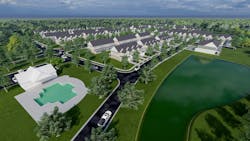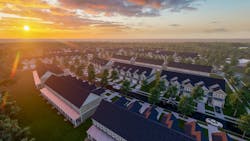Even as single-family construction slows down, the build-for-rent (BFR) market continues to surge ahead. With roughly 100,000 units built last year, annual BFR production is expected to reach about 150,000 units over the next few years, according to Hunter Housing Economics. Single-family rents hit a record high this year, CoreLogic reported.
RangeWater spotted the rising BFR wave a few years ago. Founded in 2006, RangeWater acquires, develops, manages, and invests in multifamily developments across the Southeastern and Southwestern U.S. The Atlanta-based company has developed or managed 86,000 multifamily units—with a total portfolio of over $6.3 billion. In 2021, NAHB named RangeWater the multifamily development firm of the year.
“We were noticing a trend from our broad property management portfolio,” says Chase Davidson, BFR manager, RangeWater. As Millennials were getting older, Davidson explains, they wanted homes with more space, but they also still wanted the services and sense of community provided by multifamily developments. The pandemic only intensified the need for more space, as more people started working from home.
For RangeWater, that growing trend presented a challenge: “A lot of the multifamily properties we manage and develop don’t have larger units, like 3-bedroom units, that cater to families that want to rent rather than own,” Davidson says.
RangeWater decided to change that. In 2020, the company officially launched its BFR division, Storia, with an investment of more than $800 million. Today, the company manages 115 BFR communities representing about 15,000 single-family detached homes and townhomes. BFR now accounts for 17% of the company’s portfolio.
NEW BUILD-FOR-RENT DEVELOPMENT IN CHARLESTON
It’s clearly not just Millennials who want rental homes, Davidson says. It’s also baby boomers who want to downsize and let property managers take care of all the home maintenance, as well as middle-aged families with kids who just need more room.
In July, RangeWater closed on its 10th BFR development. Located in Charleston, S.C., RangeWater’s Bellerose at Bees Ferry project will provide 155 single-family townhomes, with the first move-ins scheduled for October 2023. The 17-acre community of 3-bedroom, 2-bathroom townhomes will feature an open-air clubhouse, pool, firepits, and planned events for residents.
Developing and managing BFR differs from multifamily in a few ways, RangeWater has found. For one thing, BFR neighborhoods require more land. Getting the land approved for BFR involves diligent planning around topographical and environmental concerns. “And, in some cases,” Davidson says, BFR development involves “education of municipalities that might not be familiar with it,” he says. “We can point to our completed projects and say there’s a real cohort that wants communities that are operated like an apartment building except in a larger setting.”
In terms of design, RangeWater stays attuned to the differing desires of renters and owners. Renters, for instance, might be less interested in a walk-in closet and more inclined to use that space for a larger bathroom. Or they might be less excited about a two-car garage, more eager to add that area to the yard. (The homes at Bellerose at Bees Ferry will have one-car garages.)
For RangeWater as the developer, BFR also involves a different relationship with builders. On multifamily projects, RangeWater finds the land, gets it approved, hires a design team, hires a general contractor, and then most often sells the development to a long-term owner. “The general contractor is a key part of that equation,” says Alp Kirmizioglu, director of construction, RangeWater. “Two-thirds of our cost is in the construction contract on a typical multifamily project.”
By contrast, Kirmizioglu explains, the single-family construction market typically doesn’t have general contractors who work for a fee to build a community of homes. Instead, there are single-family homebuilders who are used to building and selling individual homes to individual owners on land the builders have developed or purchased.
A BFR development asks homebuilders to take on a general contractor role: providing construction services to a developer. That’s a different business proposition for builders. “There’s a mismatch when you take a homebuilder and put it in a multifamily-type execution. That’s where differences present themselves,” Kirmizioglu says.
As BFR has gained traction, RangeWater has been able to work through those differences. “We’re in that stage where we’re trying to find the right structure for a developer and builder to come together on a project and deliver it successfully,” Kirmizioglu says.
Still, he says, “a delivery model has not yet been settled on. I think there’s a great opportunity for someone in this space to show up and be a service provider to BFR developers as a fee builder. We don’t yet have a group that’s mastered that need.”


